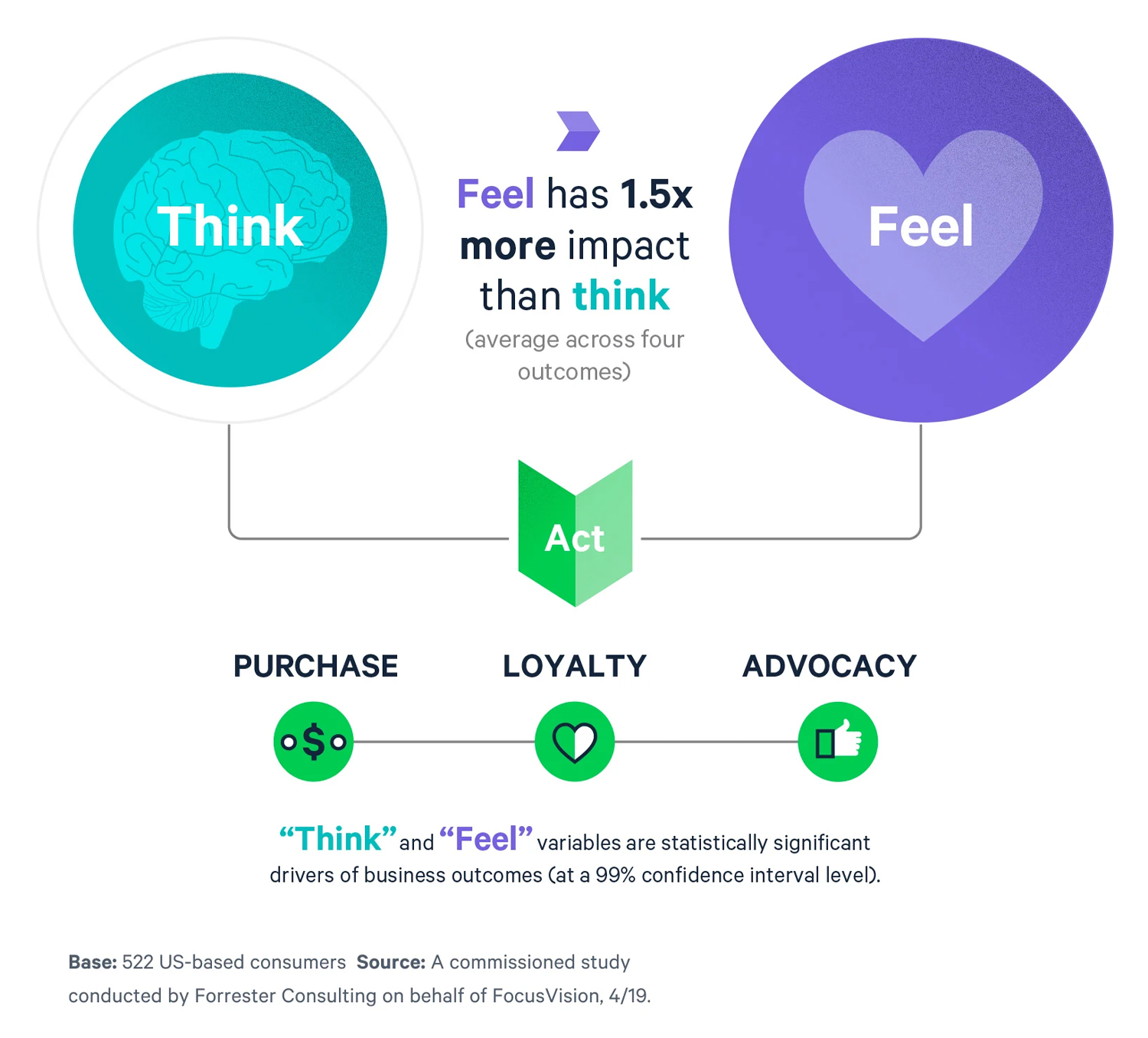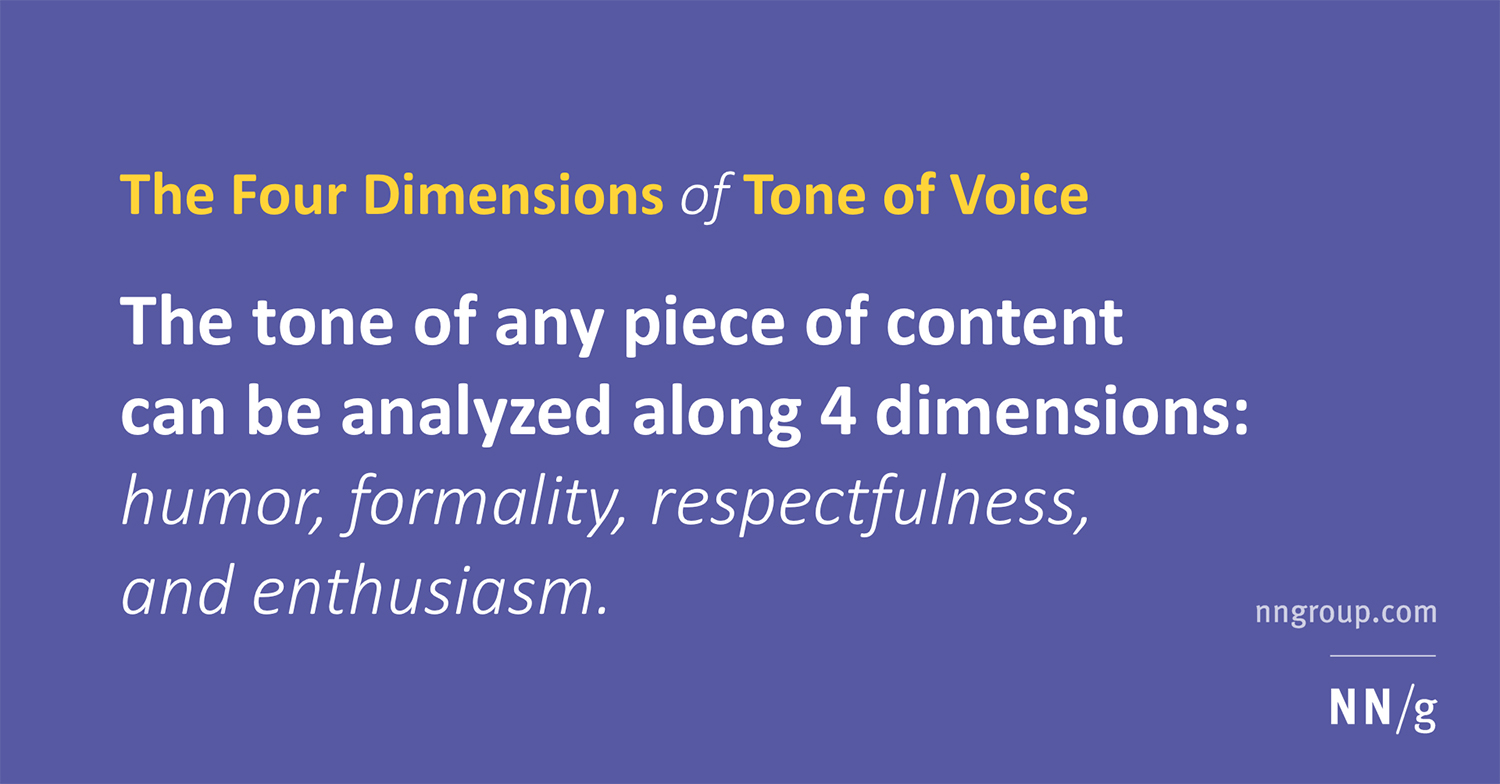SEO
Perfecting Your Brand’s Tone of Voice for SEO Copywriting

We all know when it comes to SEO, content is key.
Copywriting enables you to tell your story, gives you a chance to strategize with useful keywords, and helps you gain trust and loyalty among prospects.
But content alone won’t bring you success and build long-lasting customer relationships.
It’s your tone of voice that really resonates with your audience.
In fact, 65% of consumers say a brand’s tone of voice helps them build an emotional connection to the company.
Think of it this way: your content is the “what.” Your tone of voice is the “how.”
Tone of voice is the way your message comes across to your reader.

In verbal speech, this is communicated through pitch and inflection.
In copywriting, you portray emotion with word choice, punctuation, and style of font.
This is what elicits a response from your readers.
Understanding your audience and writing with the tone of voice they relate to is a must when developing copywriting for SEO.
Why Is Tone of Voice so Important in Online Content?
Tone of voice helps shape the overall feeling of a message – and it especially matters online.
Why? What’s so important about that?
The thing is, it actually impacts your business in lots of ways.
Consistent Brand Tone of Voice Establishes Your Brand
When you think of your favorite brands, the first thing that comes to mind is probably their logo or slogan, right?
But if that was gone and all you had to go on was their messaging, would you still recognize them?
Tone of voice plays a major role in brand identity.
When written in the same tone consistently, messages begin to reflect the image of your brand.
That’s important because people want to buy from brands that are authentic.
By developing a tone of voice that is uniquely yours, you enable people to pick your brand out of a crowd and increase the likelihood of generating more revenue.
Consistent Tone of Voice Keeps Messaging From Going Stale
Have you ever eaten a handful of stale chips?
They’re stiff, flavorless, and definitely not enjoyable. 😝
The same goes for your writing.
Just because you’re a professional company doesn’t mean your content has to be stuffy.
Loosen that top button and let your hair down a little!
Use your tone of voice to create a unique writing style that people enjoy reading.
It’s more fun and memorable and leaves a lasting impression.
Consistent Tone of Voice Creates an Emotional Connection
The main objective of your copywriting is to drive people to act, right?
With the right tone of voice, you can elicit a variety of emotions in your readers.
This is important because purchase decisions are really driven by emotion.
The way people feel is 1.5 times more impactful than the way people think.

A brand that writes with authenticity and makes an emotional connection with its audience is more likely to succeed.
Consistent Tone of Voice Gives You a Competitive Edge
Content written with a clear tone of voice is more compelling to read.
This keeps people on your site longer, entices them to click through more of your pages, and results in higher conversion rates.
All of this is good for SEO and the business as a whole.
Consistent messaging that is memorable and unique will set you apart from your competition.
Potential customers will prefer your communications over theirs and will keep coming back for more.
5 Steps to Nail Your Tone of Voice
It’s clear that tone of voice plays an important role in your SEO copywriting.
But how do you go about perfecting it for your company?
Here are five ways to identify your brand’s tone of voice and use it to drive sales.
1. Choose From the Four Dimensions

Copywriting can be characterized within four dimensions of tone of voice.
These dimensions help to simplify tone profiles for a brand’s online presence.
They are:
- Formal vs. casual.
- Funny vs. serious.
- Respectful vs. irreverent.
- Enthusiastic vs. matter-of-fact.
Each dimension is book-ended by two extremes.
Your tone could be one of the extremes, or it could be somewhere in the middle.
You could even combine some for a more unique tone of voice.
Whatever you choose, this is a great starting point to set you on a path for messaging that resonates with your audience.
2. Set Some Guidelines
The key to an effective tone of voice is consistency.
Keep yourself on target by setting some guidelines for your copywriting.
Think about the following:
- Syntax: how you’ll develop and structure your sentences.
- Grammar: use the right form of verbs, adjectives, etc.
- Vocabulary: what words you will or won’t allow.
- Punctuation: how many exclamation points are too many?
A good exercise is to come up with three words you would use to describe your business.
Then, let those adjectives guide your writing style.
If your words are “friendly,” “positive,” and “outgoing,” your messaging should be upbeat and welcoming.
Guidelines help you deliver messaging that’s consistently unique.
3. Get the Inside Scoop From Your Customers
Maybe you’re having a hard time identifying your brand voice on your own, or you’re sensing a disconnect between the company and your audience.
Reach out to the people who engage with you the most: your customers.
Survey them to get a better feel for how they perceive you.
Ask them to choose from a list of adjectives, or give them open-ended opportunities to describe ways to improve your brand.
Either way, you’ll get some valuable insight that will let you know how you can alter your tone of voice to connect with them on a deeper level.
4. Scope Out the Competition
Tone of voice is all about writing in a style that’s unique to your brand.
So, of course, you don’t want to copy what your competitors are doing.
But you can certainly gain some inspiration from seeing how they handle their messaging.
A quick Google keyword search will show you a list of competitors.
Visit their websites and read through their content.
See how they handle things like:
- Sentence structure.
- Vocabulary.
- Humor.
- Metaphors.
- Punctuation.
Learn from what they’re doing well and make note of things that could be better.
Use this intel to develop a tone of voice that works for your brand and create content that resonates with your audience.
5. Write for Your Audience
While it’s important to write in a style that’s true to your brand, you must keep your audience in mind.
Who are you writing for, corporate executives looking for professional information?
Tech-savvy millennials who respond well to GIFs?
Each audience persona is unique, so they each need a tone of voice that speaks to them.
Listen to how they speak on sales calls.
Read their comments on social media or email communication.
Pick up on the way they communicate, and use that to shape the tone of voice you use to reach them.
Use Your Tone of Voice to Define Your Brand
Your tone of voice paints a clear picture of who you are as a brand.
The way you make your readers feel through your SEO copywriting defines your personality and has a direct impact on the success of your business.
Take a close look at who you are as a brand and what perception you want people to have of you from your writing.
Creating consistent messaging that is uniquely yours will set you apart in the minds of your customers, build lasting relationships with them, and help drive success for your brand.
Image Credits:
Image 1: Studeo
Image 2: AdAge
Image 3: NN/g
SEO
Google Further Postpones Third-Party Cookie Deprecation In Chrome

Google has again delayed its plan to phase out third-party cookies in the Chrome web browser. The latest postponement comes after ongoing challenges in reconciling feedback from industry stakeholders and regulators.
The announcement was made in Google and the UK’s Competition and Markets Authority (CMA) joint quarterly report on the Privacy Sandbox initiative, scheduled for release on April 26.
Chrome’s Third-Party Cookie Phaseout Pushed To 2025
Google states it “will not complete third-party cookie deprecation during the second half of Q4” this year as planned.
Instead, the tech giant aims to begin deprecating third-party cookies in Chrome “starting early next year,” assuming an agreement can be reached with the CMA and the UK’s Information Commissioner’s Office (ICO).
The statement reads:
“We recognize that there are ongoing challenges related to reconciling divergent feedback from the industry, regulators and developers, and will continue to engage closely with the entire ecosystem. It’s also critical that the CMA has sufficient time to review all evidence, including results from industry tests, which the CMA has asked market participants to provide by the end of June.”
Continued Engagement With Regulators
Google reiterated its commitment to “engaging closely with the CMA and ICO” throughout the process and hopes to conclude discussions this year.
This marks the third delay to Google’s plan to deprecate third-party cookies, initially aiming for a Q3 2023 phaseout before pushing it back to late 2024.
The postponements reflect the challenges in transitioning away from cross-site user tracking while balancing privacy and advertiser interests.
Transition Period & Impact
In January, Chrome began restricting third-party cookie access for 1% of users globally. This percentage was expected to gradually increase until 100% of users were covered by Q3 2024.
However, the latest delay gives websites and services more time to migrate away from third-party cookie dependencies through Google’s limited “deprecation trials” program.
The trials offer temporary cookie access extensions until December 27, 2024, for non-advertising use cases that can demonstrate direct user impact and functional breakage.
While easing the transition, the trials have strict eligibility rules. Advertising-related services are ineligible, and origins matching known ad-related domains are rejected.
Google states the program aims to address functional issues rather than relieve general data collection inconveniences.
Publisher & Advertiser Implications
The repeated delays highlight the potential disruption for digital publishers and advertisers relying on third-party cookie tracking.
Industry groups have raised concerns that restricting cross-site tracking could push websites toward more opaque privacy-invasive practices.
However, privacy advocates view the phaseout as crucial in preventing covert user profiling across the web.
With the latest postponement, all parties have more time to prepare for the eventual loss of third-party cookies and adopt Google’s proposed Privacy Sandbox APIs as replacements.
Featured Image: Novikov Aleksey/Shutterstock
SEO
How To Write ChatGPT Prompts To Get The Best Results

ChatGPT is a game changer in the field of SEO. This powerful language model can generate human-like content, making it an invaluable tool for SEO professionals.
However, the prompts you provide largely determine the quality of the output.
To unlock the full potential of ChatGPT and create content that resonates with your audience and search engines, writing effective prompts is crucial.
In this comprehensive guide, we’ll explore the art of writing prompts for ChatGPT, covering everything from basic techniques to advanced strategies for layering prompts and generating high-quality, SEO-friendly content.
Writing Prompts For ChatGPT
What Is A ChatGPT Prompt?
A ChatGPT prompt is an instruction or discussion topic a user provides for the ChatGPT AI model to respond to.
The prompt can be a question, statement, or any other stimulus to spark creativity, reflection, or engagement.
Users can use the prompt to generate ideas, share their thoughts, or start a conversation.
ChatGPT prompts are designed to be open-ended and can be customized based on the user’s preferences and interests.
How To Write Prompts For ChatGPT
Start by giving ChatGPT a writing prompt, such as, “Write a short story about a person who discovers they have a superpower.”
ChatGPT will then generate a response based on your prompt. Depending on the prompt’s complexity and the level of detail you requested, the answer may be a few sentences or several paragraphs long.
Use the ChatGPT-generated response as a starting point for your writing. You can take the ideas and concepts presented in the answer and expand upon them, adding your own unique spin to the story.
If you want to generate additional ideas, try asking ChatGPT follow-up questions related to your original prompt.
For example, you could ask, “What challenges might the person face in exploring their newfound superpower?” Or, “How might the person’s relationships with others be affected by their superpower?”
Remember that ChatGPT’s answers are generated by artificial intelligence and may not always be perfect or exactly what you want.
However, they can still be a great source of inspiration and help you start writing.
Must-Have GPTs Assistant
I recommend installing the WebBrowser Assistant created by the OpenAI Team. This tool allows you to add relevant Bing results to your ChatGPT prompts.
This assistant adds the first web results to your ChatGPT prompts for more accurate and up-to-date conversations.
It is very easy to install in only two clicks. (Click on Start Chat.)
For example, if I ask, “Who is Vincent Terrasi?,” ChatGPT has no answer.
With WebBrower Assistant, the assistant creates a new prompt with the first Bing results, and now ChatGPT knows who Vincent Terrasi is.
 Screenshot from ChatGPT, March 2023
Screenshot from ChatGPT, March 2023You can test other GPT assistants available in the GPTs search engine if you want to use Google results.
Master Reverse Prompt Engineering
ChatGPT can be an excellent tool for reverse engineering prompts because it generates natural and engaging responses to any given input.
By analyzing the prompts generated by ChatGPT, it is possible to gain insight into the model’s underlying thought processes and decision-making strategies.
One key benefit of using ChatGPT to reverse engineer prompts is that the model is highly transparent in its decision-making.
This means that the reasoning and logic behind each response can be traced, making it easier to understand how the model arrives at its conclusions.
Once you’ve done this a few times for different types of content, you’ll gain insight into crafting more effective prompts.
Prepare Your ChatGPT For Generating Prompts
First, activate the reverse prompt engineering.
- Type the following prompt: “Enable Reverse Prompt Engineering? By Reverse Prompt Engineering I mean creating a prompt from a given text.”
 Screenshot from ChatGPT, March 2023
Screenshot from ChatGPT, March 2023ChatGPT is now ready to generate your prompt. You can test the product description in a new chatbot session and evaluate the generated prompt.
- Type: “Create a very technical reverse prompt engineering template for a product description about iPhone 11.”
 Screenshot from ChatGPT, March 2023
Screenshot from ChatGPT, March 2023The result is amazing. You can test with a full text that you want to reproduce. Here is an example of a prompt for selling a Kindle on Amazon.
- Type: “Reverse Prompt engineer the following {product), capture the writing style and the length of the text :
product =”
 Screenshot from ChatGPT, March 2023
Screenshot from ChatGPT, March 2023I tested it on an SEJ blog post. Enjoy the analysis – it is excellent.
- Type: “Reverse Prompt engineer the following {text}, capture the tone and writing style of the {text} to include in the prompt :
text = all text coming from https://www.searchenginejournal.com/google-bard-training-data/478941/”
 Screenshot from ChatGPT, March 2023
Screenshot from ChatGPT, March 2023But be careful not to use ChatGPT to generate your texts. It is just a personal assistant.
Go Deeper
Prompts and examples for SEO:
- Keyword research and content ideas prompt: “Provide a list of 20 long-tail keyword ideas related to ‘local SEO strategies’ along with brief content topic descriptions for each keyword.”
- Optimizing content for featured snippets prompt: “Write a 40-50 word paragraph optimized for the query ‘what is the featured snippet in Google search’ that could potentially earn the featured snippet.”
- Creating meta descriptions prompt: “Draft a compelling meta description for the following blog post title: ’10 Technical SEO Factors You Can’t Ignore in 2024′.”
Important Considerations:
- Always Fact-Check: While ChatGPT can be a helpful tool, it’s crucial to remember that it may generate inaccurate or fabricated information. Always verify any facts, statistics, or quotes generated by ChatGPT before incorporating them into your content.
- Maintain Control and Creativity: Use ChatGPT as a tool to assist your writing, not replace it. Don’t rely on it to do your thinking or create content from scratch. Your unique perspective and creativity are essential for producing high-quality, engaging content.
- Iteration is Key: Refine and revise the outputs generated by ChatGPT to ensure they align with your voice, style, and intended message.
Additional Prompts for Rewording and SEO:
– Rewrite this sentence to be more concise and impactful.
– Suggest alternative phrasing for this section to improve clarity.
– Identify opportunities to incorporate relevant internal and external links.
– Analyze the keyword density and suggest improvements for better SEO.
Remember, while ChatGPT can be a valuable tool, it’s essential to use it responsibly and maintain control over your content creation process.
Experiment And Refine Your Prompting Techniques
Writing effective prompts for ChatGPT is an essential skill for any SEO professional who wants to harness the power of AI-generated content.
Hopefully, the insights and examples shared in this article can inspire you and help guide you to crafting stronger prompts that yield high-quality content.
Remember to experiment with layering prompts, iterating on the output, and continually refining your prompting techniques.
This will help you stay ahead of the curve in the ever-changing world of SEO.
More resources:
Featured Image: Tapati Rinchumrus/Shutterstock
SEO
Measuring Content Impact Across The Customer Journey

Understanding the impact of your content at every touchpoint of the customer journey is essential – but that’s easier said than done. From attracting potential leads to nurturing them into loyal customers, there are many touchpoints to look into.
So how do you identify and take advantage of these opportunities for growth?
Watch this on-demand webinar and learn a comprehensive approach for measuring the value of your content initiatives, so you can optimize resource allocation for maximum impact.
You’ll learn:
- Fresh methods for measuring your content’s impact.
- Fascinating insights using first-touch attribution, and how it differs from the usual last-touch perspective.
- Ways to persuade decision-makers to invest in more content by showcasing its value convincingly.
With Bill Franklin and Oliver Tani of DAC Group, we unravel the nuances of attribution modeling, emphasizing the significance of layering first-touch and last-touch attribution within your measurement strategy.
Check out these insights to help you craft compelling content tailored to each stage, using an approach rooted in first-hand experience to ensure your content resonates.
Whether you’re a seasoned marketer or new to content measurement, this webinar promises valuable insights and actionable tactics to elevate your SEO game and optimize your content initiatives for success.
View the slides below or check out the full webinar for all the details.
-

 PPC6 days ago
PPC6 days ago19 Best SEO Tools in 2024 (For Every Use Case)
-

 MARKETING7 days ago
MARKETING7 days agoEcommerce evolution: Blurring the lines between B2B and B2C
-
SEARCHENGINES5 days ago
Daily Search Forum Recap: April 19, 2024
-
SEARCHENGINES6 days ago
Daily Search Forum Recap: April 18, 2024
-

 WORDPRESS6 days ago
WORDPRESS6 days agoHow to Make $5000 of Passive Income Every Month in WordPress
-

 SEO6 days ago
SEO6 days ago2024 WordPress Vulnerability Report Shows Errors Sites Keep Making
-

 WORDPRESS6 days ago
WORDPRESS6 days ago10 Amazing WordPress Design Resouces – WordPress.com News
-
WORDPRESS7 days ago
[GET] The7 Website And Ecommerce Builder For WordPress















